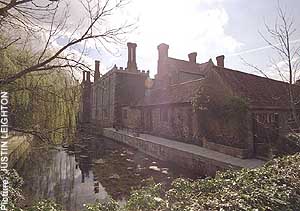A dash of Wooster sauce
Ross Clark
REAL life,
insisted P. G. Wodehouse, was something he ignored when penning the
antics of Bertie Wooster, Aunt Agatha and Gussie Fink-Nottle. But it
seems he was not quite telling the truth.
 Last
ditch: the old moat still surrounds Hunstanton Hall, which has
been divided up into separate
homes
Last
ditch: the old moat still surrounds Hunstanton Hall, which has
been divided up into separate
homes
There was one place in the country where Woosterish behaviour was
all too real. In 1926, while Wodehouse was staying with Charles Le
Strange at Hunstanton Hall in Norfolk, a guest, delayed after his
car had broken down, finally limped into the drive at three in the
morning. Not wishing to let him down, the Le Stranges roused their
servants and told them to serve him a full, five-course dinner.
Wodehouse was greatly amused, although he regretted that he could
not use such a tale in his books "because no one would believe it".
Hunstanton Hall itself was to feature large, however. Its
rambling form, part built from local carrstone and part from pebble,
and its overgrown grounds were the inspiraton for Rudge Hall, Aunt
Agatha's house at Woollam Chertsey, and parts of Blandings. But it
was the moat, in which Wodehouse regretted not being able to swim
because of the abundance of weeds, that fired his imagination most.
Its ivy-clad topography can still be traced in the pages of Very
Good, Jeeves, when Bertie saved A. B. Fillmer from drowning. The
moat, wrote Wooster, "stood to the east of the house, beyond the
rose garden, and covered several acres. In the middle of it was an
island. In the middle of the island was a building known as the
Octagon. And in the middle of the Octagon, seated on the roof and
spouting water like a public fountain, was the Right Hon A. B.
Fillmer."
Are there perhaps traces, too, of Jeeves in the butler at
Hunstanton Hall who had a row with his employer there while
Wodehouse was staying in 1931? "The butler is a cheery soul who used
to be the life and soul of the party, joining in the conversation at
meals and laughing appreciatively if one made a joke," wrote
Wodehouse in a letter. "But now he hovers like a spectre, very
strong and silent. I'm hoping peace will be declared soon."
The genteel poverty of Hunstanton Hall fascinated Wodehouse.
"It's one of those enormous houses, about two thirds of which are
derelict," he wrote in a letter to his friend William Townend.
"There is a whole wing which has not been lived in for half a
century. You know the sort of thing - it's happening all over the
country now - thousands of acres, parks, gardens, moat etc, and
priceless heirlooms, but precious little ready money. The income
from farms and so on just about balances expenses."
At least one novel, Money for Nothing, was written at Hunstanton
Hall - in a somewhat precarious fashion. "I spend most of my time on
the moat, which is really a sizeable lake," wrote Wodehouse. "I'm
writing this in a punt with my typewriter on a bed-table wobbling on
one of the seats. There is a duck close by which utters occasional
quacks that sound like a man with an unpleasant voice saying nasty
things in an undertone."
Sadly, guffawing aristocrats and stiff-upper-lipped butlers are
noticeably absent from Hunstanton Hall these days. The Le Stranges,
unable to afford the upkeep, moved to a smaller home. After a fire,
the hall was restored and divided into separate dwellings. The
gardens, though, are still the tangled backwater they were in
Wodehouse's day, and remain insulated from the unsubtle pleasures of
Hunstanton seafront, a mile to the west.
Moat Cottage, 15 miles from King's Lynn, is a two-bedroom
property carved out of a former outbuilding attached to the hall,
and faces directly onto the moat where Wodehouse used to glide by,
typewriting on his punt. While times have changed, one institution
that hasn't died out in this part of the world is the country house
weekend; in the past five years, prices have soared as Londoners and
Midlanders have piled into weekend homes.
All of which explains why the £220,000 price tag of Moat Cottage
would have been enough to send Bertie's monocle plunging into the
brown windsor. By Gad, Jeeves - enough to buy half of Market
Snodsbury.
|
